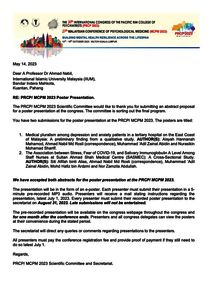Alias, Siti Afifah and Zainal Abidin, Muhammad 'Adil and Arzmi, Mohd Hafiz and Abdullah, Nor Zamzila and Md Rosli, Ahmad Nabil (2023) The association between stress, fear of COVID-19, and salivary immunoglobulin a level among sStaff nurses at Sultan Ahmad Shah Medical Centre (SASMEC): a cross-sectional study. In: The 20th International Congress of the Pacific Rim College of Psychiatry (PRCP 2023), 13-15 October 2023, Hilton Kuala Lumpur. (Unpublished)
|
PDF
Download (1MB) | Preview |
|
![[img]](http://irep.iium.edu.my/108620/8.hassmallThumbnailVersion/letter.jpeg)
|
PDF
Download (162kB) | Preview |
|
|
PDF
- Presentation
Restricted to Registered users only Download (382kB) | Request a copy |
Abstract
Introduction: The COVID-19 pandemic has given major impact globally. Healthcare workers (HCW) are forced to work with uncertainties about virus, extended working hours, and increasing numbers of cases. It is known that stress causes immunosuppression and salivary IgA (sIgA) is the immune marker most strongly related to work stress. However, the relationship between stress level, COVID-19 fear, and immunosuppression was unknown. Methods: The study aimed to investigate the relationship between COVID-19 related fear and stress to the sIgA level. A cross-sectional study has been conducted among 109 staff nurses in SASMEC, Kuantan, Pahang. Stratified randomized sampling was done for selection of participants. The PSS-10 and FCV -19S-M Questionnaires were administered for objective assessment of stress and fear followed by non-invasive saliva sample collection. Results: Quantitative measurement of IgA level was done using Enzyme-linked Immunosorbent Assay Kit (ELISA) for sIgA. Pearson correlation test and coefficient of determination (R2) were applied. 86% of participants were female, 83% were aged between 26-45 years old, 75% were married, 95% has been working more than 1 year, and 68% were working in high-risk stations. Majority of the participants scored moderate severity in terms of perceived stress (84%) and fear level (61%), and the mean sIgA level was 3.96ng/mL. Further analysis showed no linear correlation between stress and fear with salivary IgA level. Conclusion: HCW are inevitably exposed to high stress, especially during the pandemic, not just work-related stress and COVID exposure, but also other demographic and situational factors. Though the current study revealed moderate stress and fear levels among the staff nurses, and no significant association between salivary IgA and the stress and fear, further study may examine other factors such as coping skills, working environment, and protective factors that may modify perceived stress and subsequently immunological response.
| Item Type: | Proceeding Paper (Poster) |
|---|---|
| Uncontrolled Keywords: | Keywords: COVID-19, workplace stress, salivary Immunoglobulin A, healthcare workers |
| Subjects: | R Medicine > R Medicine (General) |
| Kulliyyahs/Centres/Divisions/Institutes (Can select more than one option. Press CONTROL button): | Kulliyyah of Medicine Kulliyyah of Dentistry Kulliyyah of Dentistry > Department of Fundamental Dental and Medical Sciences Kulliyyah of Medicine > Department of Community Medicine (Effective: 1st January 2011) Kulliyyah of Medicine > Department of Psychiatry |
| Depositing User: | Dr Muhammad Adil Zainal Abidin |
| Date Deposited: | 08 Dec 2023 17:08 |
| Last Modified: | 08 Dec 2023 17:08 |
| URI: | http://irep.iium.edu.my/id/eprint/108620 |
Actions (login required)
 |
View Item |


 Download Statistics
Download Statistics Download Statistics
Download Statistics